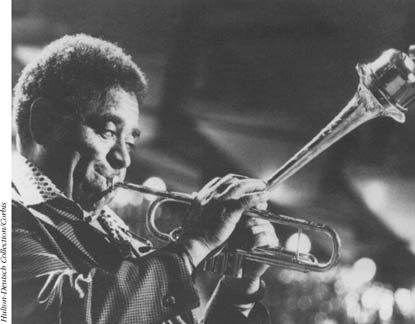
Jazz legend Dizzy Gillespie, with bis famous angled horn and inflatable cheeks, was one of music’s most colourful characters and bebop’s leading trumpeter
John Birks “Dizzy” Gillespie brought an infusion of humour and high spirits to jazz that was as rare as his sublimely dexterous playing, which was fast and fluid. His solos were characterised by breakneck runs followed by pauses, by huge interval leaps, long high notes, slurs and smears, and bluesy phrases.
A combination of wild clothes, onstage clowning, scat singing, and a habit of carrying his trumpet in a paper sack, earned Gillespie his nickname, but his talent extended beyond that of a gifted showman. He was one of the creators of bebop and modern jazz, and his style of dress created the hip jazz uniform of dark glasses and beret from the 1940s onwards.
Born on October 21, 1917, and raised in the Carolinas, Gillespie studied music on a scholarship before his family arrived in Philadelphia, where he took the place in Teddy Hill’s Orchestra that had been held formerly by trumpet whiz Roy ELDRIDGE. Cuban-born trumpeter, Mario BAUZÁ, recruited Gillespie into Cab Calloway’s band in 1939, but both men came to realise that their musical curiosity extended beyond Calloway’s somewhat traditional repertoire. Gillespie passed through several other bands, and while employed by the great jazz pianist, Earl “Fatha” Hines, made the acquaintance of saxophonist Charlie PARKER, with whom he developed the exciting form that came to be called bop, or bebop, during after-hours jamming in New York clubs.
A few years later, when Gillespie was leading his own ensembles, Bauza did his friend another good turn by introducing him to his conga-pounding cousin, Chano Pozo. Soon Gillespie had integrated both Pozo and Caribbean rhythms into his songbook—helping to open up jazz to the influences of world music—and by the 1960s would explore all kinds of Latin rhythms.
Gillespie’s groups in the late 1940s and early 1950s showcased such luminaries as Parker, a young John COLTRANE, and what later became the MODERN JAZZ QUARTET. After Parker died, in 1955, Gillespie kept bop alive, touring with Norman GRANZ’S Jazz at the Philharmonic and travelling the world as the U.S. State Department’s musical ambassador. In the 1980s, Gillespie brought participation by talent from outside the U.S. to new levels by forming his United Nations Orchestra, which at various times included players such as Arturo SANDOVAL and Paquito D’RIVERA.

Jazz legend Dizzy Gillespie, with bis famous angled horn and inflatable cheeks, was one of music’s most colourful characters and bebop’s leading trumpeter
Throughout the 1960s, 1970s, and 1980s, Gillespie continued to tour and to record with the best of his contemporaries. He cut down on solo outings, and featured Jon Faddis, a Californian trumpeter thought to be his only rightful heir. He died in January 1993.
Jeff Kaliss
SEE ALSO:
BEBOP; BIG BAND JAZZ; CUBA; JAZZ; LATIN JAZZ.
Gourse, Leslie. Blowing on the Changes: The Art of the Jazz Horn Players
(New York: Franklin Watts, 1997);
Gourse, Leslie. Dizzy Gillespie and the Birth of Bebop (Oxford: Maxwell Macmillan Int., 1994).
The Best of the Verve Years; Closer to the Source;
Dizziest; Dizzy’s Diamonds: Groovin’ High;
One Night in Washington.